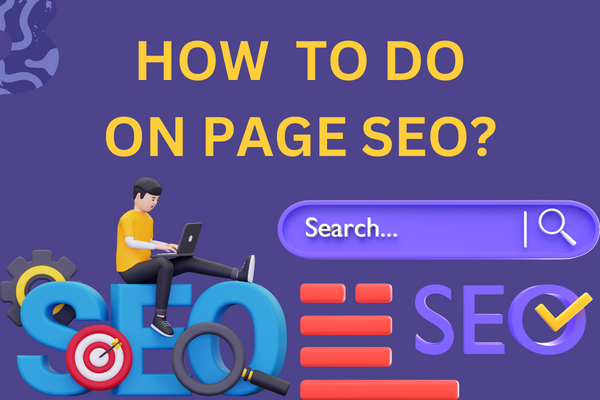What is Search Engine Optimization?
Search Engine Optimization (SEO) is a multifaceted discipline aimed at improving a website’s visibility and ranking on search engine results pages (SERPs). SEO involves various components, each playing a crucial role in optimizing a website for search engines. Here are the key components of SEO:
Keyword Research:
- Definition: Identifying and analyzing the terms and phrases users type into search engines.
- Importance: Foundation of SEO, helps in creating relevant and targeted content.
- Tools: Google Keyword Planner, SEMrush, Ahrefs.
On-Page SEO:
- Definition: Optimizing individual web pages to improve their search engine rankings.
- Key Elements:
- Title tags
- Meta descriptions
- Heading tags (H1, H2, H3)
- URL structure
- Content optimization
- Objective: Enhance relevance, readability, and overall quality of web pages.
Off-Page SEO:
- Definition: Actions taken outside of the website to impact its visibility in search engine results.
- Key Strategies:
- Link building
- Social media marketing
- Influencer outreach
- Objective: Build authority, trust, and reputation for the website.
Technical SEO:
- Definition: Optimizing the technical aspects of a website to improve its crawling and indexing by search engines.
- Key Considerations:
- Site speed optimization
- Mobile responsiveness
- XML sitemaps
- Robots.txt file
- Canonicalization
- Objective: Ensure search engines can effectively crawl and index the website.
Content Marketing:
- Definition: Creating and promoting valuable, relevant, and consistent content to attract and engage a target audience.
- Key Components:
- Blog posts
- Infographics
- Videos
- Ebooks
- Objective: Drive organic traffic, establish expertise, and encourage user engagement.
Local SEO:
- Definition: Optimizing online presence for local searches, particularly important for businesses with physical locations.
- Key Strategies:
- Google My Business optimization
- Local citations
- Online reviews
- Objective: Increase visibility in local search results.
User Experience (UX) and User Interface (UI):
- Definition: Ensuring a positive and seamless experience for website visitors.
- Key Considerations:
- Navigation structure
- Page layout and design
- Mobile-friendliness
- Objective: Improve user satisfaction and engagement.
Analytics and Reporting:
- Definition: Monitoring and analyzing website performance using data and metrics.
- Key Tools:
- Google Analytics
- Google Search Console
- SEO tracking tools
- Objective: Evaluate the effectiveness of SEO strategies and make informed decisions.
Algorithm Updates:
- Definition: Regular changes made by search engines to their algorithms, impacting how websites are ranked.
- Importance: Stay informed about updates to adjust strategies accordingly.
Conversion Rate Optimization (CRO):
- Definition: Improving the percentage of website visitors who take desired actions (e.g., making a purchase or filling out a form).
- Key Strategies:
- A/B testing
- Optimize call-to-action (CTA) elements
- Objective: Maximize the value of website traffic.
How To Do On Page SEO?
In the ever-evolving landscape of digital marketing, Search Engine Optimization (SEO) remains a critical component for enhancing online visibility and driving organic traffic. Among the various facets of SEO, on-page optimization plays a pivotal role in ensuring that your website is not only discoverable by search engines but also provides a seamless and valuable experience for users. In this comprehensive guide, we will delve into essential on-page SEO techniques to help you optimize your web pages for maximum impact.
Keyword Research and Placement:
The foundation of on-page SEO lies in effective keyword research. Identify relevant keywords and phrases that align with your content and target audience. Use tools like Google Keyword Planner or SEMrush to discover high-performing keywords. Once identified, strategically place these keywords in key elements such as:
- Title tags
- Meta descriptions
- Heading tags (H1, H2, H3)
- URL structure
- Content body
However, ensure that keyword placement feels natural and enhances the overall readability of your content.
Optimizing Title Tags and Meta Descriptions:
Craft compelling title tags and meta descriptions that not only incorporate relevant keywords but also entice users to click through. Keep title tags concise (around 50-60 characters) and meta descriptions informative (150-160 characters), providing a clear snapshot of what users can expect from the page.
User-Friendly URL Structure:
Create clean and user-friendly URLs that reflect the content of the page. Avoid long, convoluted URLs with unnecessary parameters. A well-structured URL enhances both user experience and search engine crawlability.
Example:
Header Tags (H1, H2, H3):
Utilize header tags to structure your content logically. The H1 tag should represent the main topic of the page, while H2 and H3 tags can be used to break down content into subsections. This not only aids search engines in understanding your content hierarchy but also improves readability for users.
Quality and Relevant Content:
Content is king in the world of SEO. Create high-quality, relevant, and valuable content that caters to the needs of your target audience. Regularly update and refresh your content to demonstrate its continued relevance to search engines.
Image Optimization:
Optimize images by using descriptive file names and alt tags. This not only improves accessibility for users with disabilities but also provides search engines with valuable information about the content of the images.
Internal Linking:
Establish a robust internal linking structure by linking relevant pages within your website. Internal links enhance navigation, distribute page authority, and encourage users to explore more of your content.
Mobile Responsiveness:
With the increasing use of mobile devices, ensure that your website is mobile-friendly. Google prioritizes mobile-first indexing, so a responsive design is crucial for both user experience and search engine rankings.
Page Loading Speed:
Optimize page loading speed by compressing images, leveraging browser caching, and minimizing unnecessary scripts. A faster-loading website improves user experience and positively impacts search engine rankings.
Schema Markup:
Implement schema markup to provide search engines with additional context about your content. This can enhance the display of rich snippets in search results, making your listings more attractive to users.
Key Elements of ON Page SEO
On-page SEO involves optimizing individual web pages to improve their visibility and relevance for search engines. Key elements of on-page SEO focus on making the content and structure of a page more search engine-friendly. Here are the essential elements:
Title Tags:
- Definition: HTML tags that define the title of a web page.
- Importance: Signals the page’s subject to search engines and users.
- Best Practices: Include relevant keywords, keep it concise (around 50-60 characters), and make it compelling.
Meta Descriptions:
- Definition: Brief summaries that describe the content of a web page.
- Importance: Influences click-through rates from search engine results.
- Best Practices: Keep it within 150-160 characters, incorporate keywords, and provide a clear call-to-action.
Heading Tags (H1, H2, H3, etc.):
- Definition: HTML tags used to define headings and subheadings within content.
- Importance: Helps structure content and indicates hierarchy to search engines.
- Best Practices: Use H1 for the main title, H2 for subheadings, and maintain a logical structure.
URL Structure:
- Definition: The format and arrangement of characters in a webpage’s address.
- Importance: Provides information to search engines about the page’s content.
- Best Practices: Use descriptive and readable URLs, include keywords, and avoid unnecessary parameters.
Content Optimization:
- Definition: Enhancing the content on a page to be relevant, valuable, and keyword-rich.
- Importance: Critical for search engine ranking and user engagement.
- Best Practices: Include target keywords naturally, maintain readability, and provide comprehensive information.
Keyword Placement:
- Definition: Strategic incorporation of keywords throughout the content and HTML elements.
- Importance: Signals the relevance of the page to search engines.
- Best Practices: Place keywords in title tags, meta descriptions, headings, and naturally within the content.
Image Optimization:
- Definition: Enhancing images for better search engine understanding.
- Importance: Contributes to overall page relevance and user experience.
- Best Practices: Use descriptive file names, include alt text, and compress images for faster loading.
Internal Linking:
- Definition: Linking to other relevant pages within the same website.
- Importance: Distributes page authority, improves navigation, and encourages user engagement.
- Best Practices: Use descriptive anchor text and ensure relevance to the linked content.
User Experience (UX):
- Definition: Ensuring a positive and seamless experience for website visitors.
- Importance: Impacts bounce rates and overall user satisfaction.
- Best Practices: Optimize page speed, use a mobile-friendly design, and provide clear navigation.
Schema Markup:
- Definition: Code that provides additional context about the content to search engines.
- Importance: Enhances the display of rich snippets in search results.
- Best Practices: Implement structured data for key elements like reviews, events, and products.
By focusing on these on-page SEO elements, you can create a well-optimized webpage that is not only appealing to search engines but also provides a positive experience for users.

